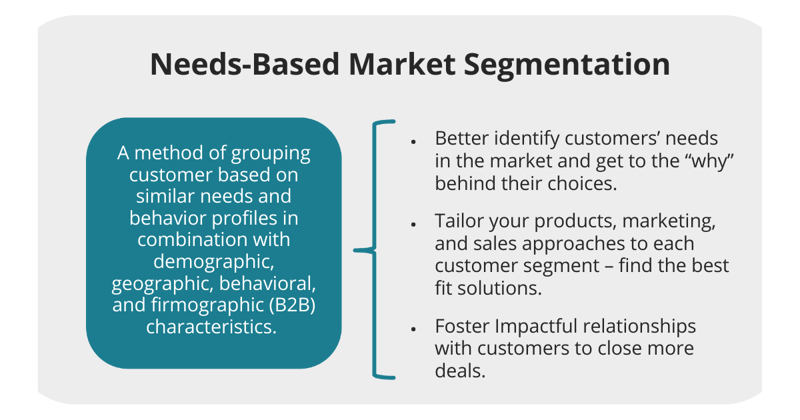High-Level Overview of Strategy
As shown in Figure 2, our strategy centers on using needs-based market segmentation to gain deep insights into the specific needs and preferences of our target customers. These insights inform the development of a robust brand architecture that clearly defines and positions each brand within the new company's portfolio. By leveraging the outputs of both needs-based market segmentation and brand architecture, we develop a modular product architecture that is adaptable and scalable, ensuring we can meet both current and future market needs for each brand. This integrated approach ensures our products are precisely aligned with customer demands, driving growth and market leadership for the new entity.

Figure 2. Needs Based Market Segmentation informs the new Brand Architecture and the results of both Needs-Based Market Segmentation and Brand Architecture are used in developing modular product architectures that deliver on the brand promises and meet the needs of target customers. The product information model both provides data to and pulls data from various corporate IT systems including Product Lifecycle Management (PLM), Enterprise Resource Planning (ERP), Manufacturing Execution Systems (MES), and Customer Relationship Management (CRM) systems, and Configure-Price-Quote systems (CPQ) to provide information on the current marketplace performance of the product architecture to, for example, P&L Owners and Product Management as well as allow salespeople and/or customers to configure products to order, and product planners to plan and simulate the future product architecture and product offering line ups.
Needs-Based Market Segmentation
Utilizing needs-based market segmentation divides a broad market into sub-groups based on specific consumer needs and preferences. This method is particularly effective in a post-merger environment, enabling companies to:
- Optimize Resource Allocation: By understanding the specific needs of different market segments, companies can allocate resources more effectively to areas with the highest potential return on investment.
- Enhance Competitive Differentiation: Tailoring products and marketing efforts to meet the unique needs of each segment helps differentiate the company’s offerings from competitors, increasing customer loyalty and market share.
- Achieve Synergy: Leveraging the combined strengths of the merged entities allows for the creation of more targeted and effective strategies, maximizing the benefits of the merger.
- Customer-Centric Focus: A needs-based approach ensures that the company remains focused on delivering value to customers, which is critical for maintaining and growing the customer base during the integration process.
- Agility and Adaptability: With a deep understanding of various market segments, companies can quickly adapt to changing customer preferences and market conditions, ensuring sustained relevance and competitiveness.

Figure 3. A description of Needs-based Market Segmentation and a brief overview of its benefits.
Brand Architecture
Brand architecture involves creating, defining, and optimizing brand and product hierarchies, roles, and relationships to maximize portfolio value while minimizing complexity and overlap. It ensures that all brands and products are organized around discrete customer needs, making the overall portfolio simple, structured, and customer-led. Effective brand architecture provides several key benefits:
- Clarity: Ensures clear differentiation between offerings and avoids customer confusion.
- Efficiency: Streamlines marketing efforts and resource allocation.
- Coordination: Enhances coordination across the company, aligning brands to business strategy and market needs.
Brand architecture serves as a vital link between brand strategy and marketplace execution, helping companies to align or bundle products and services to customer needs, drive trade-ups, and avoid overextension of brands.
 Figure 4. A visual representation of the some of the outcomes and benefits of developing a brand architecture.
Figure 4. A visual representation of the some of the outcomes and benefits of developing a brand architecture.
Modular Product Architecture
Modular Product Architecture is a strategic approach to product design that focuses on creating interchangeable components, or modules, that can be reused across multiple products. This approach offers several advantages, particularly in the context of post-merger integration for product companies:
- Flexibility and Customization: Modular architecture allows companies to quickly adapt products to meet diverse customer needs without the need for entirely new designs. This flexibility is crucial in post-merger environments where product lines need to be integrated and optimized to serve a broader customer base.
- Cost Efficiency: By reusing modules across different products, companies can achieve significant cost savings in design, production, and inventory management. This efficiency helps mitigate the financial pressures often associated with mergers.
- Scalability: Modular design facilitates scalability, enabling companies to increase production volumes and expand product lines without proportional increases in cost. This scalability supports growth and market expansion, which are common goals in post-merger scenarios.
- Agility in Market Response: The ability to quickly modify and update products using standardized modules enhances a company's agility. This is vital during post-merger integration when market conditions may change rapidly, and the company needs to remain competitive.
- Reduced Complexity: Managing fewer unique parts simplifies the supply chain and manufacturing processes. This reduction in complexity is essential for maintaining operational efficiency during the challenging period of merging two companies' operations.
In the context of post-merger integration, adopting a modular product architecture helps in creating a cohesive and streamlined product portfolio. It reduces redundancies and allows the merged entity to leverage its combined strengths more effectively, resulting in improved operational efficiency and enhanced market competitiveness. 
Figure 5. The core building blocks of a Modular Product Architecture.
Product Information Model
A Product Information Model (see Figure 3) provides unified access to all data related to a company's products. It ensures consistency, accuracy, and accessibility of product information across the organization.

Figure 6. In the wake of a merger, transforming from silos to a unified source of truth is not just important—it's essential. This shift from a document-driven, disconnected system to a data-driven, integrated model ensures that all business-critical information is easily accessible. Many businesses aim for this, but few succeed, especially during the complexities of post-merger integration. By implementing a unified product information model, we enable our newly merged teams to work more efficiently and effectively, driving better decision-making and seamless collaboration across all functions. This fosters the transformation from two companies into a single, cohesive entity in both spirit and actions.
In the post-merger integration of product companies, the product information model plays a critical role by:
- Ensuring Data Consistency and Accuracy: A unified product information model ensures that product data from both companies is consolidated into a single source of truth. This consolidation prevents discrepancies and errors that can arise from managing multiple data sources, thus improving decision-making and operational efficiency.
- Streamlining Operations: By standardizing product data and processes, the product information model simplifies operations such as production planning, inventory management, and supply chain coordination. This streamlining is crucial for minimizing disruptions and achieving seamless integration.
- Facilitating Compliance: Integrating compliance information into the product information model ensures that all products meet relevant regulatory requirements. This is particularly important in a post-merger context where differing compliance standards and documentation processes need to be harmonized.
- Enhancing Market Responsiveness: With a comprehensive and real-time view of product data, companies can quickly respond to market changes and customer demands. This responsiveness is essential for maintaining a competitive edge during the transition period.
- Supporting Collaboration: A robust product information model supports cross-functional collaboration by providing accessible and up-to-date product information to all stakeholders. This collaboration fosters a unified company culture and aligns efforts towards common strategic goals.
In summary, both Modular Product Architecture and the Product Information Model are indispensable in the post-merger integration process. They provide the structural and informational backbone needed to merge product lines efficiently, maintain operational continuity, and drive future growth. By leveraging these frameworks, companies can transform the integration process into a dynamic pursuit of market leadership and long-term success.
Employee Engagement and Company Culture
Integrating the workforce and building a unified company culture are essential for a successful merger. Engaging cross-functional teams in the definition, implementation, and on-going operation of the company's brand and product architectures fosters a unified entity. This approach has several benefits:
- Shared Understanding: Involving employees from different functions helps create a shared understanding of the company’s customers, strategy, brands, and products.
- Unified Decision-Making: Cross-functional collaboration ensures that decision-making processes are aligned with the company's strategic goals and customer needs, reducing the risk of misalignment and fostering cohesive strategies.
- Enhanced Engagement: Employees who participate in shaping the company’s future are more likely to feel engaged and committed, leading to higher morale and productivity.
- Innovation and Efficiency: Leveraging diverse perspectives from various functions encourages innovation and streamlines processes, resulting in more effective solutions and improved operational efficiency.
By clearly understanding and addressing these challenges, leaders can transform the integration process from a mere consolidation of assets into a dynamic pursuit of market leadership and growth.
Example: Whirlpool's Integration of Maytag
In 2005, Whirlpool Corporation faced significant challenges post-merger with Maytag Corporation, including a product range with over twenty brands, twenty thousand SKUs, and more than one hundred thousand different part numbers. To address these complexities and enhance profitability, Whirlpool engaged Modular Management to implement a Modular Product Architecture across their product lines.
Starting with microwave ovens, the initiative expanded to include refrigerators, dishwashers, laundry machines, and cooking products. This strategic shift not only streamlined production but also transitioned Whirlpool from a high-volume, low-variation manufacturing model to a system of mass customization. Key outcomes included a 40% reduction in part numbers, a 25% decrease in development time, and improved market responsiveness. This transformation led to sustained market leadership and profitability for Whirlpool.
By following these steps, your company can achieve significant improvements in efficiency, cost reduction, and market responsiveness. Don't miss out on the opportunity to transform your post-merger integration process and secure a competitive advantage in your industry.
Whether you want to refine your market strategy, align your brand portfolio, optimize your product architecture, or learn from real-world examples, download our guide to become a market leader and take the next step toward a successful merger.
Want to know more?
If you find this topic interesting and want to know more about how we can help with post-merger integration, please get in touch with me. I'll be happy to set up a meeting to further the conversation.
Hank Marcy
Chief Account Executive
hank.marcy@modularmanagement.com
LinkedIn





